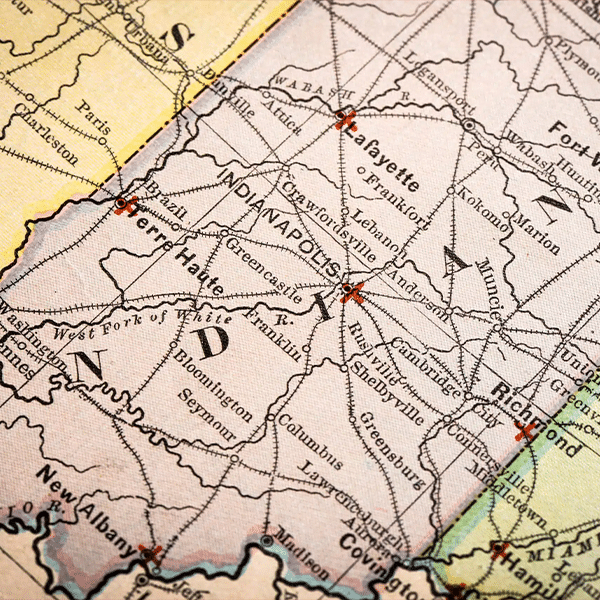Stephen Cox was enjoying retirement in Florida when the opportunity to become Indiana’s broadband director arose. After two and a half years as the head of Indiana’s Department of Homeland Security, Cox and his spouse retired and moved to Florida in 2022. But, in the next year, Indiana would form its state broadband office and Cox would return home as Indiana’s Chief Broadband Officer.
Like Michael Jordan, Cox is back better than ever after his initial retirement. Unlike Michael Jordan, he did not have big shoes to fill — when he came back to Indiana, the state broadband office was just Cox and one other person.
“It seemed like an incredibly interesting challenge,” Cox told Telecompetitor when we interviewed him, “doing something I felt would have tremendous impact for those that really needed it.”
Soon, Cox was the only employee at Indiana Broadband, the state’s broadband office. “Ultimately, I was one of two people doing this work. The other gentleman left in September 2023” — after completing the state’s Initial Proposal for the Broadband Equity, Access, and Deployment [BEAD] program — “so it was just me doing it.” Shortly thereafter, Cox began building the Indiana Broadband staff into the current team of 17.
Reaching Rural Communities in Indiana
When it comes to BEAD and other broadband programs, Cox said, “I don’t like to compare us to other state offices.” Every state has its own issues, he noted, and in Indiana they are trying to take the needs of all stakeholders into account.
“As we built the program out, we wanted to make sure we communicated with stakeholders on all aspects and get their feedback.” After hearing from some local leaders that they didn’t feel they had much say in how funding was distributed, Cox and his team built their feedback into the BEAD application process.
“We gave five points [on the BEAD application] to letters of recommendation from local governments. We want them to understand the gravity of those five points, so they don’t just write a letter of recommendation for everybody who shows up. ISPs [internet service providers] need to communicate what they actually want to do in those communities and how that aligns with the community’s needs.”
Cox pointed out that, in Indiana, the people who are unserved or underserved are mostly in rural areas. “The needs of the farmers don’t necessarily align with how ISPs want to build out. If cable lines are hanging too low, often farmers can’t get vehicles out of their fields.
“With all the ag tech [agricultural technology], farmers are the ones who really need broadband service. We work with Purdue [University] on a lot of things. They’re trying to provide new tech to farmers, and the farmers don’t have broadband connectivity. So, we’re trying to eliminate the barriers to getting them what they need so they have the tech they need.
“That’s just one example,” Cox said.
Navigating BEAD in a Time of Change
Cox said the $868 million Indiana received for their BEAD Program broadband expansion is “right in the ballpark” of what the state wanted. After seeing the news from Arkansas that 98% of that state’s unserved and underserved locations would be covered after just one round of BEAD applications, Cox and his team think they will be in good shape.
It also helps, Cox said, that the Indiana broadband expansion plans are supported by state and other federal funds. The state legislature allocated about $250 million for broadband after the Capital Projects Funds from the U.S. Treasury became available.
Indiana has already reached 110,000 addresses with broadband service through state-funded programs. This has allowed Indiana Broadband to take some of their unserved and underserved locations off their BEAD list.
“As it stands right now, there are just over 150,000 unserved and underserved locations on our eligibility list,” Cox said. With new NTIA guidance — saying states can consider areas that providers claim to have started serving since the challenge process ended in June — Cox believes the final number of BEAD locations will be between 140,000 and 150,000.
Cox is clear that not all of those locations will get fiber. “We have a satellite provider that is pre-qualified [for BEAD], also some fixed wireless providers that are pre-qualified as well,” Cox said. He expects the state to receive multiple non-fiber BEAD applications.
Indiana’s Round 1 application window ended on February 12. On January 30, when Telecompetitor interviewed him, Cox reported that Indiana had not yet received any applications. “We’ll probably receive a flood at the end,” he said.
Last week, Indiana provided an update on their Round 1 applications:
- 755 valid applications were submitted.
- 34 participating ISPs applied for funds.
- 135,667 of the state’s 144,478 eligible locations (94%) were included in at least one application.
- 118,632 of 144,478 eligible locations (82%) were included in more than one application.
Currently, the state is planning on two more rounds of applications, but Cox said they would make that determination after Round 1 applications are received.
“We’ll create project areas in Rounds 2 and 3 based on what areas didn’t receive bids or didn’t get awarded in Round 1,” said Cox. “Once we award Round 1 funding, ISPs can be more comfortable bidding in Round 2 knowing they will have infrastructure from Round 1 closer to that area. We’ve been told by multiple ISPs that Round 2 will build off their Round 1 awards.”
Of course, Indiana’s broadband expansion plans are at the mercy of changes at the federal level. “The big elephant in the room is what’s going on in D.C.,” said Cox. “All of the state directors were on a call yesterday, and all of us were on edge about what’s going to happen with that. People are keeping their ears to the ground, hoping we can all be flexible enough to pivot because we know changes are coming.”
That said, Cox said they are “feeling very upbeat” at Indiana Broadband. He looks forward to seeing people throughout the state get connected, thereby fulfilling the broadband office’s mission.
“It’s a huge undertaking,” Cox said. “All of the ISPs are glad they’re not us because of all the work to be done. But I see this as our job: the role of the government is to take care of people by providing the services we said we will provide.”
Additional information about broadband in Indiana, including links to state funding resources, awards made, state-specific Telecompetitor coverage and more, can be found on the Broadband Nation webpage for the state.

